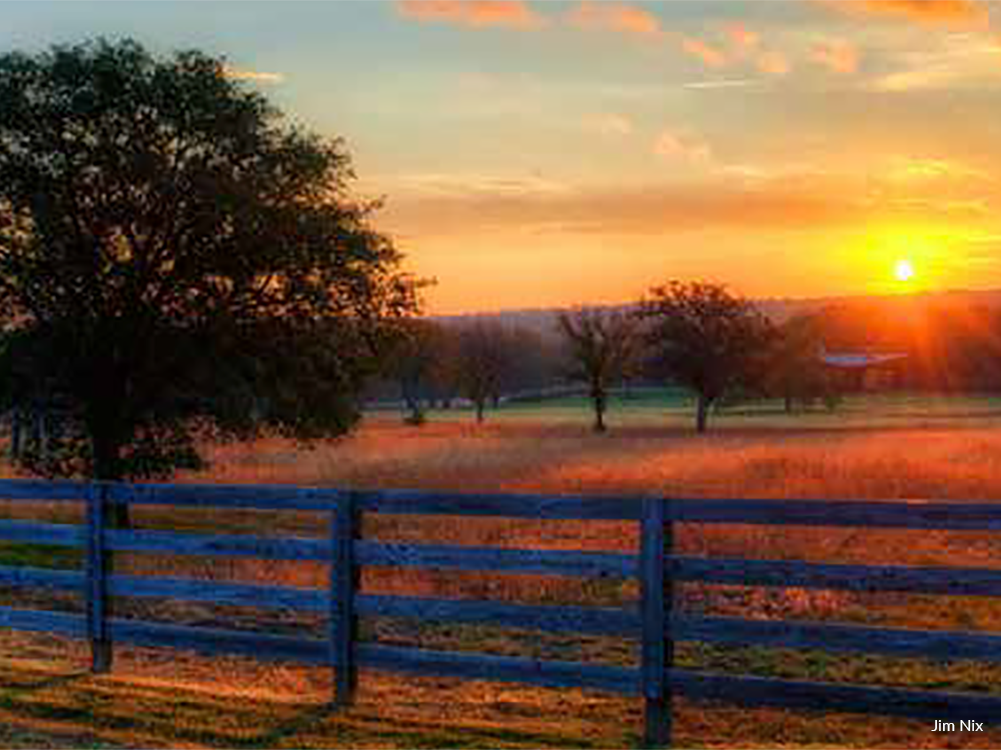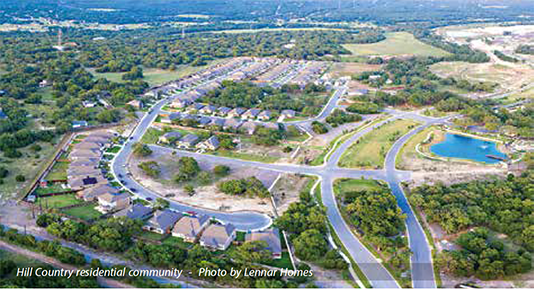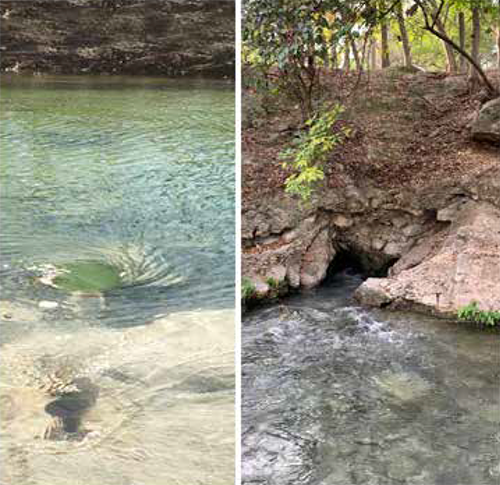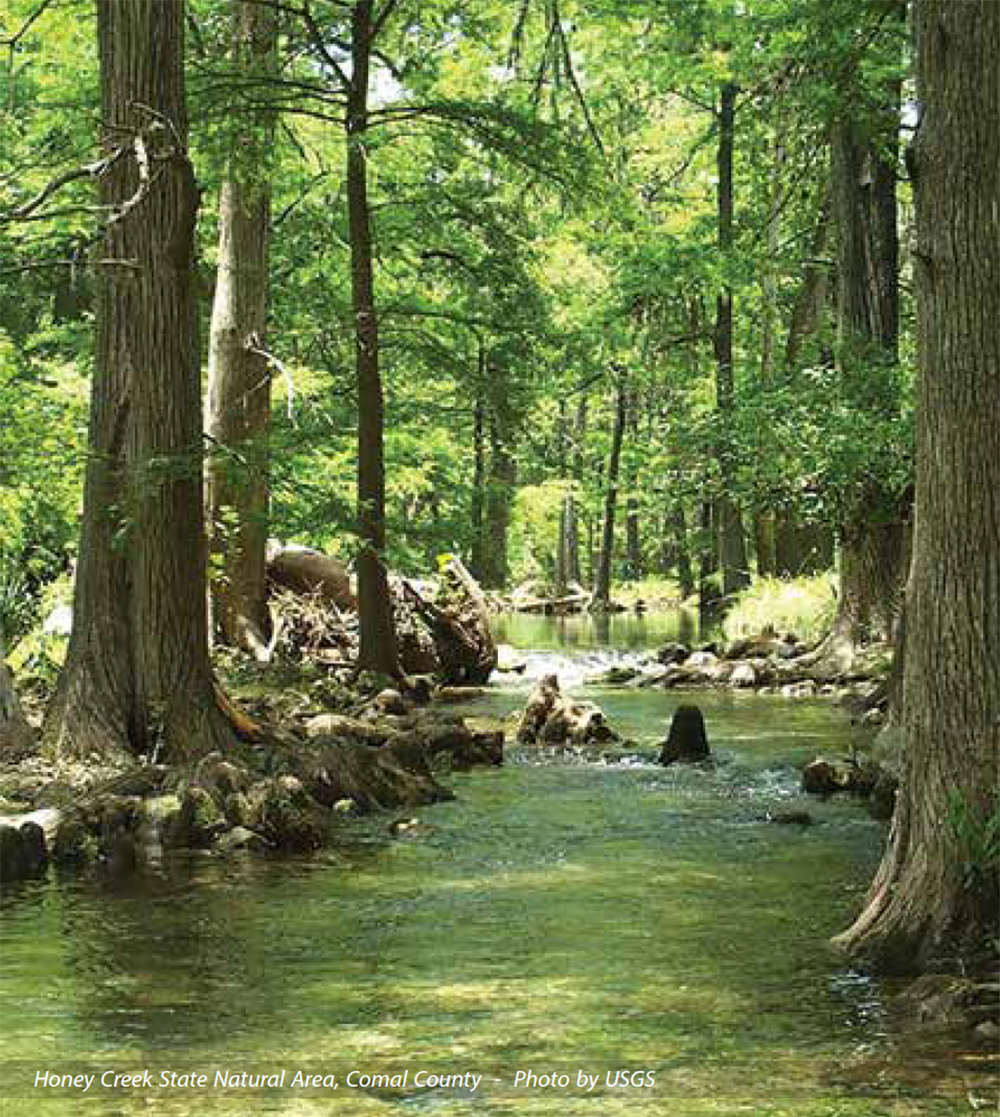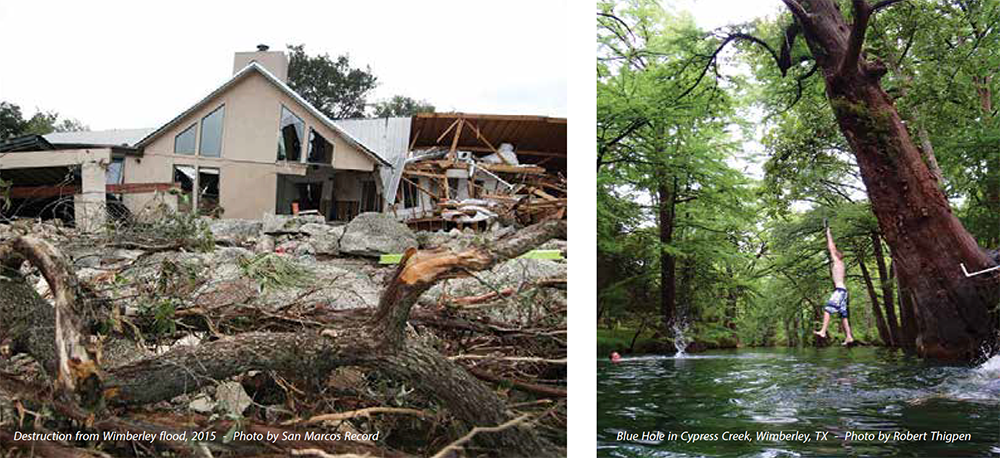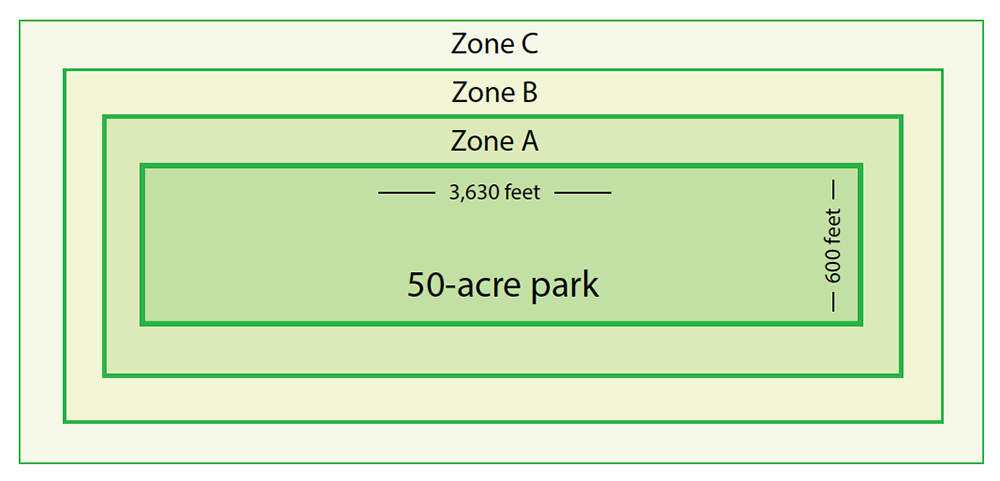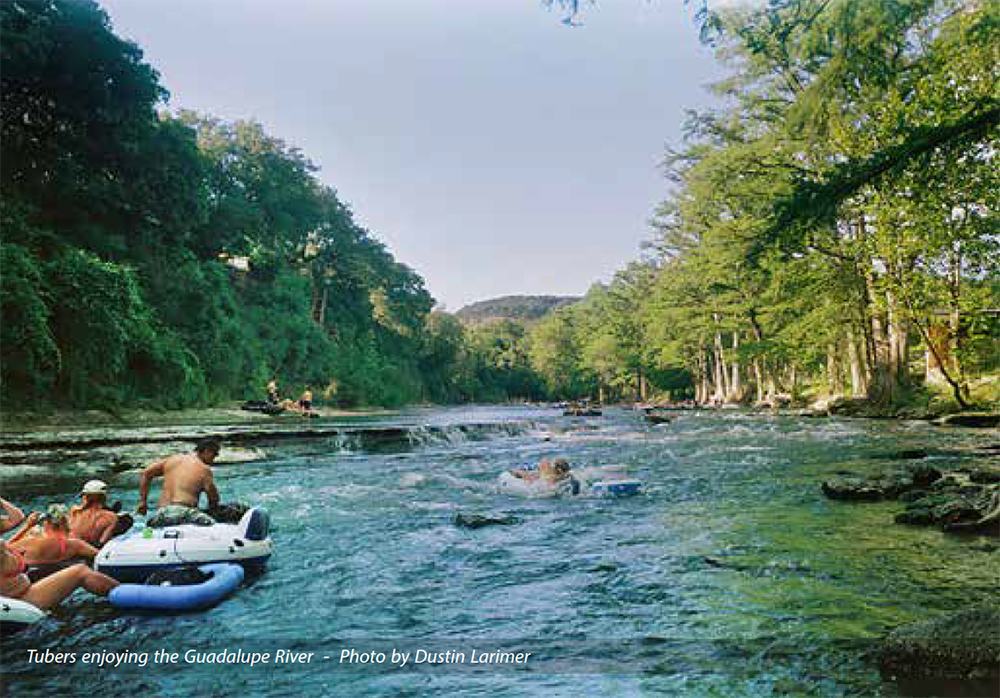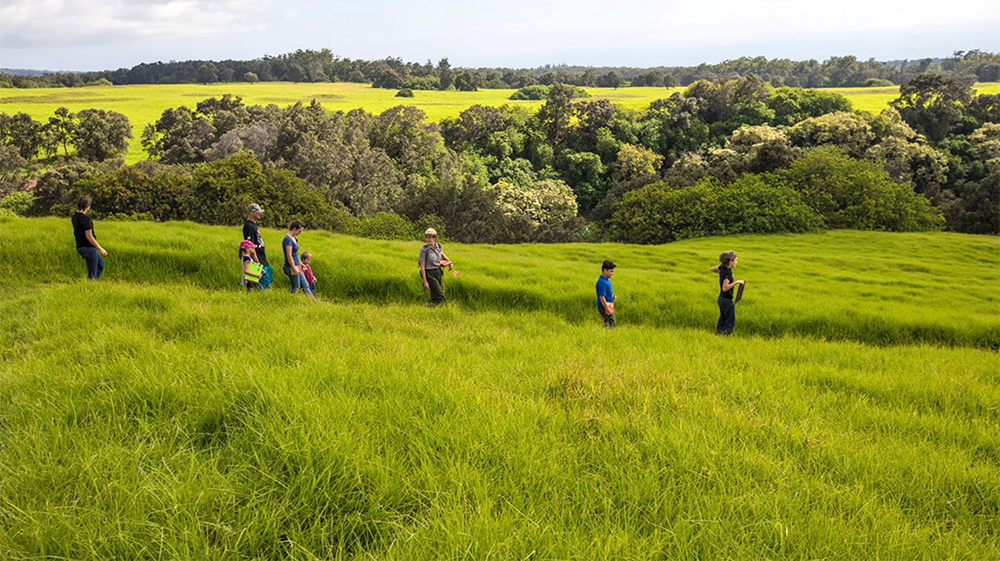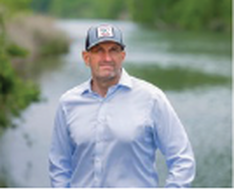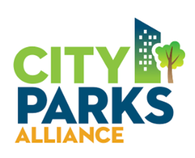Water Resources at Risk: Preserving Open Space in Comal County
By: Kaitie Moore Underwood | REALTOR®, Blue Collar Commercial Group
July 15, 2023
The Texas Hill Country has long been revered for its scenic landscapes, pristine water resources, and the allure of a peaceful retreat. In fact, a survey conducted in the 1990s revealed that a staggering 80% of Texans expressed a desire to retire in this picturesque region. However, with the increasing population and development pressures, the protection of water resources in the Hill Country has become a paramount concern.
Recently, I had the privilege of attending a thought-provoking presentation by Annalisa Peace, the Executive Director of the Greater Edwards Aquifer Alliance. The program, titled “Open Space in Comal County: Challenges & Opportunities,” shed light on the pressing issues surrounding responsible development and the urgent need for conservation efforts to safeguard our precious water resources.
One striking revelation was that Comal County, despite its pivotal location atop the Edwards Aquifer, is the only county in the Texas Hill Country that lacks meaningfully funded conservation initiatives. This stands in stark contrast to neighboring counties like Bexar, Travis, Hays, and Kendall, which have made significant strides in protecting their water resources through various means.
San Antonio, for instance, has implemented a 1/8 cent tax that has enabled the protection of an impressive total of 161,511 acres. This initiative involves the strategic acquisition of land surrounding water resources to safeguard water quality. Similarly, Travis County has allocated substantial bond funds, such as the $8.3 million from the 2011 bond and $16.6 million from the 2017 bond, to purchase easements for conservation purposes. Austin, too, levies taxes on its citizens and is actively safeguarding 26,000 acres in the Barton Springs Recharge Zone. The city has allocated $72 million for water quality and an additional $45 million for land acquisition dedicated to conservation.
Hays County, San Marcos, and Kendall County have also made commendable efforts. Hays County has committed $30 million in bonds toward conservation endeavors, while San Marcos has allocated $2 million to protect areas like Purgatory Creek. Kendall County has also commendably dedicated $20 million to the preservation of the Guadalupe River.
During the presentation, Annalisa Peace highlighted the availability of federal and foundation funding, underscoring the wealth of opportunities for financial support in our conservation endeavors. Additionally, she stressed the effectiveness of recharge dams in capturing significant amounts of water, urging further exploration and implementation of these systems in our region.
Also discussed during the presentation was the importance of “density or impervious cover restrictions for the Edwards Aquifer Recharge and Contributing zones” as implemented by cities like San Antonio, San Marcos, and Austin. These “High-Density Restrictions” (for short) serve as instrumental tools for protecting water resources. Without them, a single neighborhood can cause impairment of a stream within a relatively short span of 3-5 years.
The implementation of One Water schools in the region was briefly touched on during the presentation. Blue Hole Primary School, serving the communities of Wimberley, Woodcreek, and western Hays County, became the first One Water school in Texas, according to One Water News. This approach to water planning and management brings together various stakeholders, including developers, urban planners, community leaders, engineers, and water managers. The goal is to utilize water as thoughtfully and efficiently as possible. Excitingly, plans are underway to incorporate the One Water school modeling into the construction of three Comal County schools, demonstrating an exciting commitment to responsible water management and conservation.
Another significant suggestion put forth by Annalisa Peace was the exploration of conservation easements. These involve the purchase of development rights from property owners, thereby protecting the water resources on or adjacent to the property. Such an endeavor could prove highly beneficial for Comal County, ensuring the beginnings of organized and vital water source preservation.
During the presentation, it was heartening to learn about recent conservation efforts, such as the purchase and protection of 1,200 acres near Vintage Oaks in New Braunfels. However, there was an underlying sentiment that our current efforts may not be sufficient to cope with the rapid growth in our county. Concerns were raised about the number of “straws in the drink” and the need for more comprehensive and proactive measures.
A concerning issue highlighted during the presentation was the proposed development and discharge of 600,000 gallons of grey water into a dry creek via a tributary at the Harrison Tract. Stephanie Johnson of My Canyon Lake reported that the New Braunfels land owner wants to maximize the potential sales value of his 550 acres of land by obtaining a wastewater discharge permit. Concerned citizens seek to stop him, as such discharge could adversely affect our drinking water over time. Situations such as this one underscore the importance of maintaining vigilance and responsible regulations.
In conclusion, Annalisa Peace’s presentation shed light on the challenges and opportunities that lie before us in Comal County. It is vital that we recognize the significance of responsible development and conservation efforts to protect our precious water resources. With the examples set by neighboring counties and the availability of federal and foundation funding, we have the means to make a positive and lasting impact. By embracing innovative strategies, such as encouraging stormwater recharge, high-density restrictions, and conservation easements, we can ensure a sustainable and vibrant future for the Texas Hill Country.
Let us join hands in preserving the natural beauty and water resources that define our region, working towards a harmonious balance between development and conservation. By doing so, we can safeguard the splendor of the Texas Hill Country for generations to come. Should you like to learn more and explore ways to become involved in our area’s conservations efforts, please explore the links below:
(Sources: Annalisa Peace of Greater Edwards Aquifer Alliance; One Water News; Stephanie Johnson of My Canyon Lake)
July 15, 2023
The Texas Hill Country has long been revered for its scenic landscapes, pristine water resources, and the allure of a peaceful retreat. In fact, a survey conducted in the 1990s revealed that a staggering 80% of Texans expressed a desire to retire in this picturesque region. However, with the increasing population and development pressures, the protection of water resources in the Hill Country has become a paramount concern.
Recently, I had the privilege of attending a thought-provoking presentation by Annalisa Peace, the Executive Director of the Greater Edwards Aquifer Alliance. The program, titled “Open Space in Comal County: Challenges & Opportunities,” shed light on the pressing issues surrounding responsible development and the urgent need for conservation efforts to safeguard our precious water resources.
One striking revelation was that Comal County, despite its pivotal location atop the Edwards Aquifer, is the only county in the Texas Hill Country that lacks meaningfully funded conservation initiatives. This stands in stark contrast to neighboring counties like Bexar, Travis, Hays, and Kendall, which have made significant strides in protecting their water resources through various means.
San Antonio, for instance, has implemented a 1/8 cent tax that has enabled the protection of an impressive total of 161,511 acres. This initiative involves the strategic acquisition of land surrounding water resources to safeguard water quality. Similarly, Travis County has allocated substantial bond funds, such as the $8.3 million from the 2011 bond and $16.6 million from the 2017 bond, to purchase easements for conservation purposes. Austin, too, levies taxes on its citizens and is actively safeguarding 26,000 acres in the Barton Springs Recharge Zone. The city has allocated $72 million for water quality and an additional $45 million for land acquisition dedicated to conservation.
Hays County, San Marcos, and Kendall County have also made commendable efforts. Hays County has committed $30 million in bonds toward conservation endeavors, while San Marcos has allocated $2 million to protect areas like Purgatory Creek. Kendall County has also commendably dedicated $20 million to the preservation of the Guadalupe River.
During the presentation, Annalisa Peace highlighted the availability of federal and foundation funding, underscoring the wealth of opportunities for financial support in our conservation endeavors. Additionally, she stressed the effectiveness of recharge dams in capturing significant amounts of water, urging further exploration and implementation of these systems in our region.
Also discussed during the presentation was the importance of “density or impervious cover restrictions for the Edwards Aquifer Recharge and Contributing zones” as implemented by cities like San Antonio, San Marcos, and Austin. These “High-Density Restrictions” (for short) serve as instrumental tools for protecting water resources. Without them, a single neighborhood can cause impairment of a stream within a relatively short span of 3-5 years.
The implementation of One Water schools in the region was briefly touched on during the presentation. Blue Hole Primary School, serving the communities of Wimberley, Woodcreek, and western Hays County, became the first One Water school in Texas, according to One Water News. This approach to water planning and management brings together various stakeholders, including developers, urban planners, community leaders, engineers, and water managers. The goal is to utilize water as thoughtfully and efficiently as possible. Excitingly, plans are underway to incorporate the One Water school modeling into the construction of three Comal County schools, demonstrating an exciting commitment to responsible water management and conservation.
Another significant suggestion put forth by Annalisa Peace was the exploration of conservation easements. These involve the purchase of development rights from property owners, thereby protecting the water resources on or adjacent to the property. Such an endeavor could prove highly beneficial for Comal County, ensuring the beginnings of organized and vital water source preservation.
During the presentation, it was heartening to learn about recent conservation efforts, such as the purchase and protection of 1,200 acres near Vintage Oaks in New Braunfels. However, there was an underlying sentiment that our current efforts may not be sufficient to cope with the rapid growth in our county. Concerns were raised about the number of “straws in the drink” and the need for more comprehensive and proactive measures.
A concerning issue highlighted during the presentation was the proposed development and discharge of 600,000 gallons of grey water into a dry creek via a tributary at the Harrison Tract. Stephanie Johnson of My Canyon Lake reported that the New Braunfels land owner wants to maximize the potential sales value of his 550 acres of land by obtaining a wastewater discharge permit. Concerned citizens seek to stop him, as such discharge could adversely affect our drinking water over time. Situations such as this one underscore the importance of maintaining vigilance and responsible regulations.
In conclusion, Annalisa Peace’s presentation shed light on the challenges and opportunities that lie before us in Comal County. It is vital that we recognize the significance of responsible development and conservation efforts to protect our precious water resources. With the examples set by neighboring counties and the availability of federal and foundation funding, we have the means to make a positive and lasting impact. By embracing innovative strategies, such as encouraging stormwater recharge, high-density restrictions, and conservation easements, we can ensure a sustainable and vibrant future for the Texas Hill Country.
Let us join hands in preserving the natural beauty and water resources that define our region, working towards a harmonious balance between development and conservation. By doing so, we can safeguard the splendor of the Texas Hill Country for generations to come. Should you like to learn more and explore ways to become involved in our area’s conservations efforts, please explore the links below:
- Comal County Conservation Alliance: https://www.comalconservation.org/
- Native Plant Society of Comal: https://npsot.org/chapters/new-braunfels/
- Friends of Dry Comal Creek: https://www.facebook.com/Stop3009VulcanQuarry/
- Native Plant Society of Texas- New Braunfels: https://npsot.org/chapters/new-braunfels/
- Preserve Lake Dunlop Association: https://www.plda.org/
- Preserve Our Hill Country Environment: https://www.preserveourhillcountry.org/
- Texas Cave Management Association: https://www.tcmacaves.org/
- & collaborators, League of Women Voters of the Comal Area: https://www.lwvcomal.org/
(Sources: Annalisa Peace of Greater Edwards Aquifer Alliance; One Water News; Stephanie Johnson of My Canyon Lake)
Preserving Open Space in Comal County: Challenges and Opportunities
| newbrauanfelsparksboard-1-10-2023_1_.pdf |
Presentation to the New Braunfels Parks Advisory Board
By Annalisa Peace
Greater Edwards Aquifer Alliance
January 10, 2023
By Annalisa Peace
Greater Edwards Aquifer Alliance
January 10, 2023
|
A poll taken in the 1990s by Texas Monthly found that 80% of Texans want to retire to the Hill Country. We are literally loving the Hill Country to death.
Comal County is at the forefront of urban development due to its steady increase in population over the past decade.
WHAT OTHERS ARE DOING Since May 2000, the City of San Antonio has preserved 161,511 acres funded by a portion of a voter-approved 1/8 -cent sales tax venue. In 2008, the EAA joined with the City of San Antonio in an interlocal cooperation agreement to provide geological assessment and easement monitoring in support of the growing program. The EAA continues to perform geologic evaluations on the prospective properties and conducts the annual monitoring essential to the integrity of the program. — Travis County Travis County purchases easements using voter-approved bond funds, and also accepts donated easements, which may provide estate or income tax benefits to the landowner. Travis County voters approved $8.3 million in 2011 for the purchase of conservation easements, and another $16.6 million in 2017. Travis County prioritizes properties along identified conservation corridors, properties adjacent to existing preserves, parkland, or other conserved lands, and properties with unique features such as springs, historical/archaeological sites. The targeted conservation corridors include Wilbarger Creek, Gilleland Creek, the Colorado River, Onion Creek, and the Pedernales River. — City of Austin The City of Austin’s Water Quality Protection Lands Program has protected 26,603 acres of land in the Barton Springs Recharge and Contributing Zones through funding approved in 1998. In 2018, voters in the City of Austin approved $149 million for parks and recreation. Of this amount, $72 million was dedicated to water quality protection land acquisition and $45 million went to parkland acquisition. The City of Austin also limits impervious cover on the Edwards Aquifer Recharge Zone to 15% and has a robust watershed protection program. — Hays County
— San Marcos Council To Consider $2M In Parks Bond Funds For Purgatory Creek The City of San Marcos is moving ahead with one of its priority parks and open space projects just in time for the new year. |
On Tuesday, San Marcos City Council will consider approval of an InterlocalAgreement with Hays County, authorizing the city to use $2 million in parks bond funds toward the purchase of real property and preliminary work associated with the Purgatory Creek Improvements Project.
— Kendall County In 2022 voters approved Proposition for $20 million, in funding to protect the Guadalupe River, aquifer and groundwater supplies, wildlife habitat, and working ranches and agricultural lands. These funds will protect Kendall County’s drinking water sources and preserve quality of life by protecting the last remaining natural areas and wildlife habitat before they are lost to development forever. OPPORTUNITIES FOR FUNDING
OPPORTUNITIES TO MATCH FUNDS FROM
Green Infrastructure Funding Microsite The National Wildlife Federation (NWF) launched a new funding microsite for communities interested in pursuing federal funding and/or technical assistance for nature-based solutions and green infrastructure projects.The interactive database allows users to search and sort the more than 70 types of federal grants that fund nature-based solutions based on factors such as eligible recipients, project purpose, and the match required. It also provides information about the typical application cycles, and contact information for each program. Access the database here: FundingNatureBasedSolutions.nwf.org New Roadmap to Accelerate Nature-Based Solutions for Climate Progress and Equity The Whitehouse released a Roadmap and over 100 federal informational resources to scale-up nature-based solutions to address climate change, nature loss and inequity. The reports, announced in November during the United Nations Framework Convention on Climate Change’s 27th Conference of the Parties (COP27) in Egypt, respond to a call from President Biden earlier this year to identify opportunities to expand the use of nature-based solutions across the federal government. Learn more here: https://www.epa.gov/green-infrastructure/green-infrastructure-federal-collaborative#What's%20New CONSIDERATIONS
“Government, private corporations, and citizens must act promptly to direct urban development away from the aquifer through control of infrastructure investment….” and “Restrict impervious cover to levels that will sustain existing water quality."
| ||
Benefits of Investing in Open Space
| benefits_of_investing_in_open_space_brochure.pdf |
Published 2020
|
Numerous academic studies and the anecdotal experience of neighboring communities have clearly demonstrated the benefits of protecting open space. Protecting open space and water sources in Comal County is an investment in the future of our county that will pay dividends to county taxpayers for generations to come.
BENEFITS OF OPEN SPACE COME IN SEVERAL WAYS
AVOIDING COSTS The cost of publicly funded community services is higher for residential developments than for other land uses. Contrary to popular belief, increased residential |
development does not reduce homeowners’ property taxes. Studies consistently report that over a wide range of residential densities, and especially in rapidly growing communities, the public costs associated with residential development exceed the public revenues that accrue from it.1 A 2004 study of 98 communities in 25 states concluded that they spent $1.16 for every dollar of revenue from residential developments, compared with $0.27 for commercial developments and $0.35 for farm or open space.
These conclusions are similar to a study that included Hays County, where each dollar of property tax revenue from housing required $1.26 in public community service costs. In contrast, commercial and open lands required about $0.30 in community service costs per dollar of revenue generated.2 Costs to support residential housing are not only higher but are increasing in Comal County, where rapid population growth is creating widespread land conversion from open space to residential development. The resulting per person cost for county services increased by 51% from 2010 to 2018.3 |
|
MAINTAINING NATAURAL SYSTEMS
Natural systems have provided for our human needs throughout history. Development, particularly the impervious surfaces of rooftops, parking lots, and roads, compounded by the destruction of natural vegetation, disrupts those natural systems. Once they are disrupted, artificial systems must be installed, often at much higher costs. Our aquifers depend on the unimpeded flow of water in their recharge zones to replenish their supply. Approximately one-third of the land area of Comal County is in the Edwards Aquifer Recharge Zone. If rainwater can no longer freely flow into the caverns, caves, sinkholes, and cracks that guide it to the aquifer, it becomes runoff, causing erosion and flooding, and carrying pollutants into surface waters. Therefore, less water and less good-quality water is available for our use. The majority of Comal County residents outside city limits depend on water from wells drilled into the Edwards Aquifer. For New Braunfels city residents and businesses, water from the Edwards Aquifer is the least expensive source of water for the New Braunfels Utilities (NBU), and its availability impacts their water bills. According to a 2019 report by NBU, water from the Edwards Aquifer costs $207 per acre-foot. Water from NBU’s other sources costs between two and seven times as much. Water availability increases and water costs decrease if the Edwards Aquifer is allowed to continue to replenish through natural, unimpeded recharge.4 Trees, shrubs, grasses, and other natural vegetation in a watershed reduce the cost of purifying water for human use. One study demonstrated a direct correlation between water treatment costs and the percent of the watershed that was forested. In the study, the cost of treating one million gallons of water dropped from $115 to $37 as the percent of forest in the watershed grew from 10% to 60%.5 Natural open space in floodways and floodplains helps reduce the impact of floods by giving water a place to go, reducing the speed and intensity of the flood surge, and decreasing property damage. The savings can be significant, as much as $4 for every $1 invested in land preservation.6 |
|
|
INCREASING PROPERTY VALUES
Homebuyers are willing to pay more for homes near parks and open/green spaces. One study found a 10% – 20% increase in the value of property in relation to proximity to open space. That increase varied based on the characteristics and quality of the open space.7 The study also demonstrated a direct relationship between property value and proximity to parks, as demonstrated by the chart below: Property value increases were greatest in Zone A, immediately adjacent to the park. Property value increases were somewhat less in Zones B and C, which were |
farther from the park, but still greater than surrounding areas. Increased property values generate increased property tax revenues for the local government.
A regional example of this proximity impact can be found in the City of Wimberley, where Cypress Creek runs through the city. When the Cypress Creek Project estimated the cost of possible degradation of the creek, it was concluded that adjacent properties would see a 25% to 45% reduction in value from a prolonged reduced flow in the creek. Further and more prolonged reductions would have an even greater impact.8 |
SUPPORTING ECONOMIC HEALTH
Roughly 20% of New Braunfels’s economy and 27% of its jobs are related to tourism, making tourism one of the largest industries in New Braunfels and Comal County.9 People come to enjoy the rivers, scenic beauty, and rural charm of the area. Maintaining a high-quality, appealing natural environment is essential to this industry.
Roughly 20% of New Braunfels’s economy and 27% of its jobs are related to tourism, making tourism one of the largest industries in New Braunfels and Comal County.9 People come to enjoy the rivers, scenic beauty, and rural charm of the area. Maintaining a high-quality, appealing natural environment is essential to this industry.
|
ATTRACTING BUSINESSES
Historically, business location decisions were made largely on the availability of transportation, proximity to needed natural resources, or local political climate. Now many businesses fight to attract and retain highly skilled, knowledgeable workers. Those workers often care deeply about where they live. They want a quality environment, which includes high-quality public services, excellent schools, cultural opportunities, and access to nature. That is why many successful, innovative companies build campuses with trees and open space, rather than traditional office buildings.10 Communities trying to attract such businesses must provide a high quality of life. |
IMPROVING OUR HEALTH
Nearly 1,000 studies from around the world have found a strong correlation between time spent in green or natural spaces and good mental, emotional, and physical health. Some medical professionals now even offer prescriptions for people to spend time in nature to improve their health.11 Although it is challenging to monetize the benefit of nature to our health, a healthy population is the foundation of a vital community and a strong economy.
Nearly 1,000 studies from around the world have found a strong correlation between time spent in green or natural spaces and good mental, emotional, and physical health. Some medical professionals now even offer prescriptions for people to spend time in nature to improve their health.11 Although it is challenging to monetize the benefit of nature to our health, a healthy population is the foundation of a vital community and a strong economy.
CONCLUSION
Protecting open space in Comal County is an investment in the future of our economy and the health of our people, residents and tourists alike. Investing in natural areas is as essential to the future well-being of Comal County as investing in infrastructure such as roads and schools. Retaining property in an open or natural state is often its most economical and beneficial use. As unprecedented growth continues in Comal County, there is an urgent need to make these investments in open space now,
while we still can.
Protecting open space in Comal County is an investment in the future of our economy and the health of our people, residents and tourists alike. Investing in natural areas is as essential to the future well-being of Comal County as investing in infrastructure such as roads and schools. Retaining property in an open or natural state is often its most economical and beneficial use. As unprecedented growth continues in Comal County, there is an urgent need to make these investments in open space now,
while we still can.
REFERENCES
- John Crompton, Parks and Open Space: The Highest and Best Use of Public Land? Journal of Park and Recreation Administration, 2001.
- Farmland Information Center, Cost of Community Services Studies, 2016.
- Comal County Comprehensive Annual Financial Reports of 2010 and 2018.
- NBU FY2020 Budget and Financial Operating Plan, City Council Workshop, October 2019.
- The Trust for Public Land, The Economic Benefits of Land Conservation, 2007, p. 24.
- Siglo Group, Valuing Economic Benefits of Texas Conservation Lands, Texas Land Trust Council, 2019.
- The Trust for Public Land, The Economic Benefits of Land Conservation, 2007, p. 4.
- Cibolo Nature Center, The Economic Value of Investing in Water and Land Conservation in Boerne/Kendall County.
- Economic Development Strategic Plan, New Braunfels, TX, 2012.
- Jonas Altman, Apple’s New Headquarters Proves That the Coolest Offices Will Have These 3 Things, Inc.com, 2017.
- Jim Robbins, Ecopsychology: How Immersion in Nature Benefits Your Health, Yale Environment, 2020.
ACKNOWLEDGEMENTS
This analysis draws heavily on the work of the Cibolo Nature Center’s The Economic Value of Investing in Water and Land Conservation in Boerne/Kendall County. Production of this publication courtesy of Great Springs Project.
The Time to Conserve Land is Now
By Annalisa Peace for the New Braunfels Herald Zeitung
December 24, 2022
December 24, 2022
|
The Edwards Aquifer, source of Comal Springs, is recognized as one of the most prolific karst aquifer systems in the world. Storm water enters and travels through the system with amazing speed, allowing for rapid recharge of this elegant water source.
However, this porosity and rapid channel flow also makes the Edwards extremely vulnerable to contamination. According to the Texas Commission for Environmental Quality, “Pollutants on and near the surface can directly enter the aquifer with little natural attenuation and travel long distances in a relatively short period of time.” Although there are state and local regulations in place to protect the Edwards Aquifer, reporting shows that regulations are not sufficient to prevent declines in water quality. Preserving land on the recharge zone in its natural state is the most surefire method of protecting this valuable water supply. Towards this end, the cities of Austin and San Antonio, along with counties Travis, Hays, and most recently, Kendall have all allocated public funds to purchase land and conservation easements within the Edwards Aquifer Recharge Zone. The Greater Edwards Aquifer Alliance and the above mentioned local governments believe that landowners should be compensated by the public for providing the ecosystem services we all rely on to preserve and sustainably manage our natural resources. The various programs, such as San Antonio’s Edwards Aquifer Protection program, have proven highly successful in pairing willing land owners with public funding to preserve approximately 6% of the Recharge Zone. With unprecedented growth in the Edwards region, especially in Comal County, opportunities to preserve land are rapidly disappearing. We are caught in a vicious cycle where demand inflates the price of land, which leads to higher density developments and a more urbanized landscape. We have found, however, that there are landowners who welcome the opportunity to preserve the land they love in |
perpetuity while continuing to live and work on their property through the sale of development rights.
It is to our advantage to act quickly to secure park land and conservation easements, not only as it relates to preserving water quality but, to mitigate the very real threats of flash floods. Land on the recharge zone is especially efficient at soaking up stormwater. Conserving this land can go a far way in negating the need for costly drainage infrastructure and loss of property due to flood damage. The non-point source pollution of stormwater runoff contaminated by urban development, increased volumes of waste water discharges from new treatment plants, and the proliferation of on-site sewage facilities now threaten to diminish the quality of Comal County’s rivers, springs and streams. Waterways bordered by high density suburban development are far more likely to become impaired to the point that they are no longer suitable for contact recreation. Comal County and the City of New Braunfels benefit greatly from sales tax income and profits generated by recreational tourism, especially from the thousands who visit to tube down the Comal and Guadalupe rivers. Imagine the impact to recreational businesses if Comal Springs were to be temporarily closed due to high bacterial counts, as has happened twice at Austin’s Barton Springs. Such a future is not inevitable. We at the Greater Edwards Aquifer Alliance believe that investing in green infrastructure in the form of land preservation not only provides the most cost effective means of protecting our water resources and diminishing flooding but, is an essential component of preserving the quality of life, safety, and economic security of the citizens of Comal County. We must move forward now to allocate public funds and plan for honest and effective application of these funds to preserving land where it will do the most good. |
Ecopsychology: How Immersion in Nature Benefits Your Health
By Jim Robbins
January 9, 2020
January 9, 2020
A growing body of research points to the beneficial effects that exposure to the natural world has on health, reducing stress and promoting healing. Now, policymakers, employers, and healthcare providers are increasingly considering the human need for nature in how they plan and operate.
|
How long does it take to get a dose of nature high enough to make people say they feel healthy and have a strong sense of well-being? Precisely 120 minutes. In a study of 20,000 people, a team led by Mathew White of the European Centre for Environment & Human Health at the University of Exeter, found that people who spent two hours a week in green spaces — local parks or other natural environments, either all at once or spaced over several visits — were substantially more likely to report good health and psychological well-being than those who don’t. Two hours was a hard boundary: The study, published last June, showed there were no benefits for people who didn’t meet that threshold. The effects were robust, cutting across different occupations, ethnic groups, people from rich and poor areas, and people with chronic illnesses and disabilities. “It’s well-known that getting outdoors in nature can be good for people’s health and well-being, but until now we’ve not been able to say how much is enough,” White said. “Two hours a week is hopefully a realistic target for many people, especially given that it can be spread over an entire week to get the benefit.” The study by White and his colleagues is only the latest in a rapidly expanding area of research that finds nature has robust effects on people’s health — physically, mentally, and emotionally. “When I wrote Last Child in the Woods in 2005, this wasn’t a hot topic,” said Richard Louv, a journalist in San Diego whose book is largely credited with triggering this |
movement and who coined the term Nature Deficit Disorder. “This subject was virtually ignored by the academic world. I could find 60 studies that were good studies. Now it’s approaching and about to pass 1,000 studies, and they point in one direction: Nature is not only nice to have, but it’s a have-to-have for physical health and cognitive functioning.” These studies have shown that time in nature — as long as people feel safe — is an antidote for stress: It can lower blood pressure and stress hormone levels, reduce nervous system arousal, enhance immune system function, increase self-esteem, reduce anxiety, and improve mood. Attention Deficit Disorder and aggression lessen in natural environments, which also help speed the rate of healing. In a recent study, psychiatric unit researchers found that being in nature reduced feelings of isolation, promoted calm, and lifted mood among patients. The growing body of research — combined with an intuitive understanding that nature is vital and increased concerns about the exploding use of smart phones and other forms of technology — has led to tipping point at which health experts, researchers, and government officials are now proposing widespread changes aimed at bringing nature into people’s everyday lives. For example, researchers and policymakers now talk about “park deserts” in urban areas. Cities are adding or enhancing parks, and schools and other institutions are being designed with large windows and access to trees and green space — or blue space, as in aquatic environments. Businesses are increasingly aware of the desire among employees for access to green spaces. “It’s needed to attract a skilled work force,” said Florence Williams, author of The Nature Fix. “Young people are demanding high-quality outdoor experiences.” |
|
The number of “forest schools” — which have long been a tradition in Scandinavia and where much of the learning takes place in natural settings in the outdoors — has mushroomed in the United States, up by 500 percent since 2012, according to Louv. Oregon recently passed a ballot measure to raise money for outdoor schools, and the state of Washington just became the first state to license outdoor preschools, where much of the play and learning occurs outside.
The organization Children & Nature Network, founded by Louv and others, advocates for more time in nature for children, tracks the research, and has a long list of abstracts that summarize studies on the subject on its website. And The Trust for Public Lands (TPL) has just finished a seven-year project to map the parks of the U.S., with the aim of identifying places in need of parkland. “We’ve mapped 14,000 communities, 86 percent of the nation, and looked at who does and doesn’t live within a 10-minute walk of a park,” said Adrian Benepe, a senior vice president of TPL. The organization has a Ten Minute Walk campaign to work with mayors across the U.S. to make sure all people have that kind of access. An increasing number of healthcare providers are also embracing the back-to-nature paradigm. One organization, Park RX America, founded by Robert Zarr of Unity Healthcare in Washington, D.C., declares its mission “to decrease the burden of chronic disease, increase health and happiness, and foster environmental stewardship, by virtue of prescribing Nature during the routine delivery of healthcare by a diverse group of health care |
professionals.” The organization has 10,000 parks in its “prescribing platform.”
The global Association of Nature and Forest Therapy Guides shows clients how to use immersion in nature for healing. “The forest is the therapist,” the group’s slogan reads. “The guides open the door.” Studies show that the effects of nature may go deeper than providing a sense of well-being, helping to reduce crime and aggression. A 2015 study of 2,000 people in the United Kingdom found that more exposure to nature translated into more community cohesion and substantially lower crime rates. And while more vegetation is thought to encourage crime by providing security for criminals, another study found the opposite — vegetation abundance is associated with a reduction in assault, robbery, and burglary, although not theft. Still, many of these studies are correlational rather than causal. That means it’s hard to show that natural landscapes cause these effects, though these things happen when people are in a natural environment. Sara L. Warber, professor of family medicine at the University of Michigan, noted that there are no “randomized, controlled studies” on the effects of nature on human health. Nonetheless, she said, there are epidemiological studies and measurements of before and after exposure to nature, and the results from this research are robust. |
|
Peter H. Kahn, a professor of psychology at the University of Washington who has worked on these issues for decades, is encouraged by the new focus on the subject but concerned that the growing interest in more contact with nature relies too much on only experiencing it visually. “That’s important, but an impoverished view of what it means to interact with the natural world,” he said. “We need to deepen the forms of interaction with nature and make it more immersive.”
What are the active ingredients in a dose of nature? Pioneers in this work, Rachel and Stephen Kaplan, who began studying the subject in the 1970s, devised Attention Restoration Theory, which holds that paying attention in bustling cities, at work, or in other stressful environments requires a good deal of effortful attention. In a natural environment, however, the Kaplans found that people paid attention more broadly and in a less effortful way, which leads to far more relaxed body and mind. Japanese researchers have studied “forest bathing” — a poetic name for walking in the woods. They suspect aerosols from the forests, inhaled during a walk, are behind elevated levels of Natural Killer or NK cells in the immune system, which fight tumors and infections. A subsequent study, in which essential oils from cedars were emitted in a hotel room where people slept, also caused a significant spike in NK cells. However, this growing field might be defined, it is gaining momentum. In a recent paper, 26 authors laid out a framework to |
create a formal role for the positive impacts nature has on mental health and to formulate a model for conserving nature in cities and integrating it into planning for these health effects.
“There is an awakening underway today to many of the values of nature and the risks and costs of its loss,” says one researcher.“We have entered the urban century, with two-thirds of humanity projected to be living in cities by 2050,” said Gretchen Daily, director of the Natural Capital Project at Stanford University and a senior author of a recent paper arguing that the cognitive and emotional benefits of nature should be factored into economic ecosystem service models. “There is an awakening underway today to many of the values of nature and the risks and costs of its loss. This new work can help inform investments in livability and sustainability of the world’s cities.” While the research has grown leaps and bounds, Kahn and others argue in a recent review paper that research into the topic is still lacking in many ways, and they lay out a research agenda they say would help formalize the role of nature in public health policy. Understanding nature’s therapeutic effects may be arriving at a propitious moment. Some studies have found that anxiety over climate change is a growing phenomenon. Ironically, one of the best antidotes for that might be a dose of green space. “If I am feeling depressed and anxious and worried about the environment,” Warber said, “then one of the best things I can do is go out in nature.” |
Open Space 101
|
WHAT IS OPEN SPACE?
Open space” lacks a consistent definition, but the phrase generally refers to land that is undeveloped or lightly developed for uses other than agriculture. The State of New York offers a useful and inclusive definition of open space: Open Space is land that is not intensively developed for residential, commercial, industrial or institutional use. It serves many purposes, whether it is publicly or privately owned. It includes agricultural and forest land, undeveloped shorelines, undeveloped scenic lands, public parks and preserves. It also includes water bodies such as lakes and bays. What is defined as open space depends in part on its surroundings. A vacant lot, community garden or small marsh can be open space in a big city. A narrow corridor or pathway for walking or bicycling is open space even though it is surrounded by developed areas. Historic and archeological sites are often associated with significant open space and are a part of our common heritage. WHY IS IT IMPORTANT? From panoramic western landscapes to urban pocket parks and from mountain to shore, open space is a cherished part of America’s national and local identities. Its ecological importance and ability to sustain our spirit have long been appreciated, but our understanding of the economic value of these lands and waters has been steadily increasing in recent years. Forests, rangelands, and other natural lands and working landscapes provide human society with a range of essential and fundamentally irreplaceable services, such as pure water, abundant wildlife, and a moderating influence on our changing climate. HOW IS IT AT RISK? At the same time, America’s rural, urban, and suburban open spaces are dwindling rapidly. Each year about two million acres of open space are converted to other uses -- an amount that equals almost 6,000 acres a day -- and most of this conversion happens close to where many people live. Layered on top of an existing panoply of threats -- development pressure, resource extraction, non-native invasive species, altered natural processes -- is the specter of climate change, whose stresses will likely exacerbate these other, more familiar hazards. What we need now to protect America’s open space is continued commitment, increased investment, and renewed hope for the future. WHERE IS IT FOUND? Fortunately, awareness and action to protect open space has never been greater. Citizens, land trusts, and public agencies have rallied to protect many of America’s finest lands and waters through a variety of innovative conservation approaches. In addition, many local communities have programs to preserve open space for a variety of purposes, ranging from recreation to water quality to wildlife habitat. |
One of the most auspicious aspects of open space planning is that for the most part it happens locally. Communities with the will and the grassroots involvement to protect land and other resources can do tremendous things. Communities with the will and the grassroots involvement to protect land and other resources can do tremendous things. As author Samuel Brody has noted, “Some of the most effective policy tools that can either threaten or protect ecosystems are in the hands of county officials, city councils, town boards, local planning staff, and general public rather than federal or regional agencies.”
Many people do not realize the power that local communities have to determine their own future. Indeed, a landmark Supreme Court decision in 1926 -- Village of Euclid, Ohio v. Ambler Realty Co. -- stated that “every community has the right to determine its own character and the nature of development within.” This right encompasses decisions of whether or not to grow, how to grow, and how to conserve open space and other resources that the community perceives as valuable. As a result, local governments have the power to create land-use plans that control growth and development while directing development to locations where sewer, water, roads, and other public infrastructure are already available. This means that no community is required to follow the path of urban sprawl and exurban development, an approach that is expensive, wasteful of energy, and likely to fragment open space. Yet conventional land-use planning has often not lived up to its potential. Planning expert Philip Berke has pointed out that While land use planning is a potentially effective long-term solution to future ecological decline, research-based evidence indicates that existing land use plans are too weak to encourage development that recognizes ecological systems. In addition, public apathy and a lack of political will may also hamper conservation planning efforts. In fact, communities sometimes adopt public land use policies that unwittingly encourage loss. Berke also points out the mismatch between the local scale at which communities do their planning and the “ecosystem” or “landscape” scales at which many ecological processes operate. Wide-ranging species in particular are unlikely to benefit from open space or land-use planning that occurs city-by-city or county-by-county. One key to resolving this dilemma is greater interaction among local planners, conservation biologists, and ecologists, which can enhance communities’ capacity to view and place themselves within the broader regional context (Noss 2007). Also crucial is the use of the best available planning data, which can often separate perceived conflicts from real conflicts (Stein 2007). |
Unique and Creative Approaches for Conservation
By Lon Shell
Opinion Editorial May 16, 2022
Opinion Editorial May 16, 2022
|
As our population surges, will the Hill Country retain its character? I believe it can, however it is a challenge that will require unique and creative approaches to balance that growth with preservation of the very things that drive it.
We live in a remarkable place with beautiful resources, wonderful people, and amazing opportunities. People want to live here. They want to experience the quality of life that our region provides. They want to swim in the rivers and creeks, take in the views from the hilltops, and breathe clean air—and at the same time, have access to good jobs, affordable homes, low taxes, and a safe place to raise families. Unfortunately, without careful attention, this growth will negatively affect all the things we cherish and that drew us to this region in the first place. In the recently published State of the Hill Country report, we can see a significant percentage of this growth is occurring in the unincorporated areas of the Hill Country counties. These areas are represented by County Judges and County Commissioners that have little to no authority related to land use. A rock quarry can be established next to an existing neighborhood. A new subdivision with hundreds of homes can be built off a narrow, rural road with no shoulders or turn lanes. Rarely a day goes by that I don’t have conversations with concerned residents related to land use and its impact on their lives. Through these discussions most folks understand property rights and the importance of protecting them, and only ask that counties be granted reasonable opportunities to protect their way of life and the safety of their communities. Rapid growth affects our community in many ways from stressing our transportation system to depleting our water resources. Growth requires costly and constant attention because road building is expensive, and all lives depend on water. The burden of this cost is carried by our citizens. We realize residential growth alone will likely not support the level of revenue required to manage it, so the local taxpayer is continuously strained as they are asked to pay for what others have likely caused. It is not that current residents don’t want to be welcoming, they just want to make sure their investment and quality of life are protected so that future generations may experience the Hill Country they have grown to love. So, what can be done? First, we must recognize that residents of the Hill Country are resilient and eager to work on solutions. We should encourage constructive dialogue with local and state representatives on what types of local authority can protect our property rights and the character of this special place. I believe we can find reasonable and responsible ways in which counties can allow their citizens to have more of a say in addressing what happens in their community. That, after all, is the purpose of representing them in the first place. |
Second, let's share our success stories and build on the momentum. Our residents understand that transportation infrastructure improvements and flood mitigation projects must be made, but ask also that we invest in preservation of our natural resources.
In 2020, Hays County voters approved a $75 million-dollar investment in parks and open space with 70% approval. This is in addition to approving bond packages of $3.5 million in 2001 and $30 million in 2007. Many of the projects included in these bond initiatives focused on land conservation. These public investments can help offset the ever-growing impacts related to development. Conservation projects can help protect water quality, mitigate flood risks, preserve wildlife habitat, as well as provide public recreation opportunities and preserve rural lands that will help maintain the character of the Hill Country. When residents support investments in conservation like they have in Hays County, it becomes a model and motivation for others in the region to build similar support. Third, we must leverage investments in conservation. Our citizens deserve to see their money not only used for public benefit but used efficiently. We have seen that sometimes relatively small investments can be used to produce large results. Collaboration with regional partners can lead to innovative uses of current funds, like the Texas Water Development Board’s Clean Water State Revolving Fund for land acquisition related to water quality protection and flood mitigation. The proper use of these funds can help offset future costs for expensive infrastructure projects while at the same time preserving open space. Finally, if growth is inevitable, we must strive to provide homes for future residents in a way that respects those that are here now and those that came before us. This means working with those investing in our region and finding creative ways to include and incentivize our community’s conservation goals. Hays County is now working on the creation of guidelines and rules for conservation-minded development. I believe we can provide a balance to growth by working with the development community on ways to lessen the adverse impacts of their activities by conserving portions of land that otherwise would be developed. The resulting neighborhoods will not only be recognized as models for responsible development, but they will also be valued and enjoyed by those that choose to live there. Whether we have been here for generations or only a short time, we are all shareholders in the Hill Country. We have the responsibility to ensure our investment here is not only in our home or the property which we own, but we must also invest in protecting the character of the Hill Country as we make room for others to enjoy it. |
Lon Shell has served as a Hays County Commissioner since 2017. In that role he has been an active voice for land conservation, the need for more groundwater science, protecting the county’s natural resources, and supporting trails and public parks for people.
Why City Parks Matter
CITY PARKS PLAY A VITAL ROLE IN THE SOCIAL, ECONOMIC, AND PHYSICAL WELL-BEING OF AMERICA’S CITIES
AND THEIR RESIDENTS.
As cities become more densely populated and concern about the impact of climate change increases, planners, elected officials, and community advocates are taking a fresh look at parks and their potential to help address critical urban infrastructure and public
health issues. Parks are now recognized as powerful tools for urban communities and local economies.
AND THEIR RESIDENTS.
As cities become more densely populated and concern about the impact of climate change increases, planners, elected officials, and community advocates are taking a fresh look at parks and their potential to help address critical urban infrastructure and public
health issues. Parks are now recognized as powerful tools for urban communities and local economies.
BENEFITS OF URBAN PARKS
City parks provide access to recreational opportunities, increase property values, spur local economies, combat crime, and protect cities from environmental impact.
City parks provide access to recreational opportunities, increase property values, spur local economies, combat crime, and protect cities from environmental impact.
|
City parks encourage active lifestyles and reduce health costs. Physical activity can reduce or prevent many physical and mental health problems. Parks also reduce the costs of healthcare: maintaining a healthy weight saves $1,500 per person in healthcare costs per year. |
City parks strengthen local economies and create job opportunities. Parks attract residents and businesses, increase revenue for cities, spur private investment, and increase job opportunities. In Denver, $1.2 million in federal park grants resulted in over $2.5 billion in local public and private investments. |
City parks make cities more resilient. Cities are integrating parks with their infrastructure plans to manage stormwater and mitigate flooding. Cost-sharing across agencies can save money on park creation, maintenance and programming allowing cities to fully leverage the many benefits of parks to cities and residents. |
|
City parks increase community engagement and reduce crime. Planning and programming that engages residents in the design and of their local parks fosters a sense of community and helps ensure that the parks reflect the needs of the community. Community involvement and greening of vacant urban land, for example, has been shown to decrease crime and generate additional support for nearby park projects. |
City parks help clean the air and improve public health. Trees in urban parks remove up to 7,111,000 tons of toxins from the air annually at a value of $3.8 billion to cities. Green spaces also filter rain, reducing water pollution, protecting drinking water, and decreasing the rates of waterborne illness. Green spaces in cities also help cool our cities, reducing the heat-island effect. |
City parks are a tool for cities to achieve their equity goals. Vibrant parks and green spaces are at the center of resilient and equitable cities, and increasingly, agencies and public officials are leveraging the many benefits of parks to meet their city-wide equity goals. Through community engagement and applying an equitable approach to park funding, park leaders, public, private, civic, and philanthropic partners are directing investments to communities in greatest need. |









